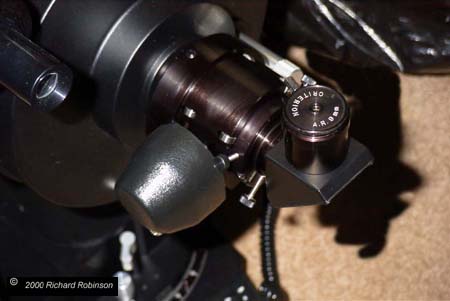 |
This
photo shows the JMI-NGF-S Motofocus attached to the LX 200. The JMI
comes with a ring that screws onto the back of the SCT. The focuser
assembly then attaches to this ring with three set screws. At the
eyepiece end the NGF-S accepts either a 2 inch eyepiece or 1-1/4 inch eyepiece.
This photo shows the Meade Star diagonal attached to the NGF-S using the 1-1/4 inch eyepiece adapter and an old 9 mm eyepiece to plug up the hole for storage. The MX-5C will fit into the NGF-S as either a 2-inch eyepiece or a 1-1/4 inch eyepiece. |
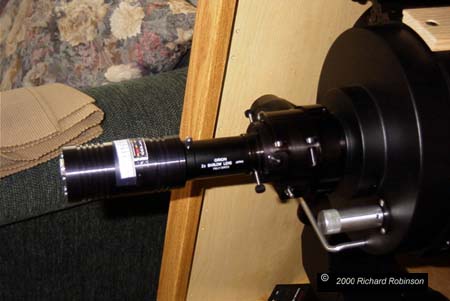 |
This
photo shows the MX-5C attached to the NGF-S through a Barlow lens.
I have both a 2X and 3X Barlow, so can achieve either f20 or f30 with this
arrangement.
Note that the MX-5C cable end extends outward about 8 inches from the back of the NGF-S when coupled through a Barlow lens in this manner. There are scope positions where the CCD will hit the bottom of the fork or the base of the equatorial wedge. |
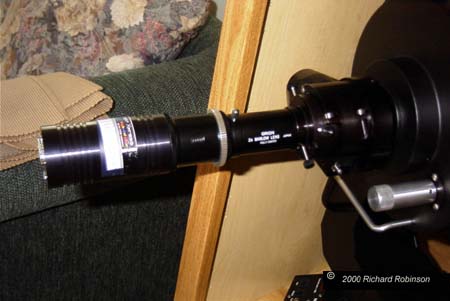 |
This
configuration provides the ultimate in image fuzziness.
It places an adapter for eyepiece projection in line between a Barlow lens and the MX-5C. With it I can achieve either f40 or f60 focal ratios. However, I've never gotten successful images with it. It is too difficult to focus and the image is just too unsteady. I have used the eyepiece projection without the Barlow successfully. With my equipment I can achieve a focal ration of about f20 with it, if I do not use the Barlow. |
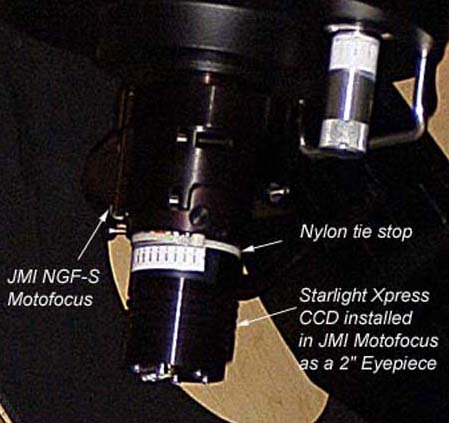 |
This
configuration is the shortest optical train length I can achieve.
It positions the MX-5C at the prime focus of my f-10 system.
The JMI Motofocus will accept 2 inch diameter eyepieces, so the MX-5C will slide in with out any additional adapters. I have placed a nylon tie around the MX-5C to act as a stop. This insures that I always position the MX-5C at the same position. I've also taped a paper scale to help orient the camera with the right ascension/declination axis. |
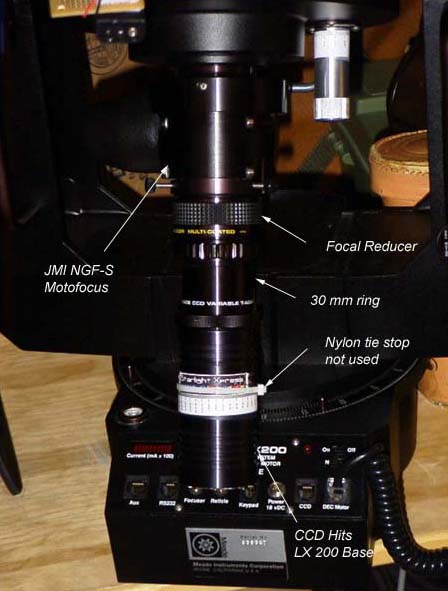 |
This
photo shows the optical system set up for operation at f3.3.
The Meade f3.3 focal adapter is attached to the JMI Motofocus using an adapter purchased from ADIRONDACK VIDEO ASTRONOMY. This adapter slides into the JMI 2" eyepiece position and then duplicates the threads on the back of the SCT. This allows using any SCT accessory with the JMI. The 30 mm ring is installed to result in a f3.3 optical configuration. An additional adapter (also ordered from ADIRONDACK) is required to be installed between the 30 mm ring and the MX-5C because the pitch of the threads in the 30 mm ring is 0.75 threads per mm while the pitch of the threads on the inside of the MX-5C barrel 1.0 threads per mm. Finally the MX-5C is attached to this final adapter. Note that in this configuration, the CCD will hit the LX 200 base and that the nylon tie serves no purpose in this configuration. |
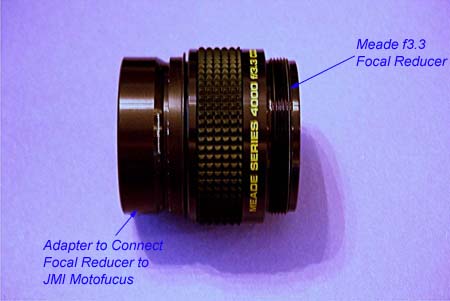 |
This
photo shows the Meade f3.3 focal reducer attached to the JMI Motofocus
adapter.
This adapter slides into the JMI 2" eyepiece position and then duplicates the threads on the back of the SCT. This allows using any SCT accessory with the JMI. |
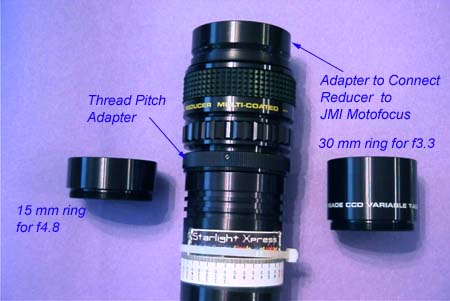 |
This
photo shows the Meade f3.3 focal reducer and all adapters I've used.
The JMI Motofocus adapter and the thread pitch adapter were purchased from ADIRONDACK VIDEO ASTRONOMY. The 15 mm extension ring and 30 mm extension ring were included with the Meade focal reducer. The photo shows the connection without any extension rings. This configuration results in a focal-diameter ration of about f6.6. |
|
|
|